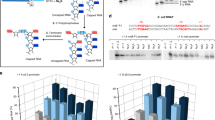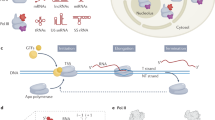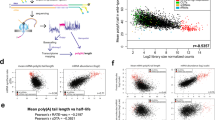Abstract
GENETIC information encoded in the nuclear DNA of a eukaryotic cell is selectively transcribed into an array of nuclear RNA molecules heterogeneous in size, base sequence and half-life. The α-amanitin-sensitive, DNA-dependent RNA polymerase isolated from nucleoplasm is thought to catalyse the transcription of heterogeneous nuclear RNAs (HnRNA). While in the nucleus, the length of HnRNAs is modified in two ways: first, HnRNAs are lengthened by addition of a poly(A) sequence. The ATP–polynucleotidylexotransferase isolated and purified from several eukaryotic tissues is presumed to catalyse the sequential addition of AMP moieties to the 3′ terminus of the HnRNA. Secondly, HnRNAs bearing poly(A) tails are thought to be shortened by cleavage of a portion of the nucleotide sequence at the 5′ terminus and the remainder transported to the cytoplasm. After association with ribosomal subunits, the processed transcripts form polysomes and function as mRNAs in the translation of specific polypep-tides. Inferences as to the processing of HnRNA to give rise to mRNA are drawn from experiments using cordycepin (3′-deoxyadenosine) as an inhibitor of RNA synthesis1–2. Interpretation of many of these experiments rests on the assumption that the cordycepin selectively inhibits the addition of polyadenylic acid to HnRNA4–6. On the other hand, Klenow7 has shown that cordycepin is phosphorylated to 3′-dATP by Erlich ascites tumour cells, and using a bacterial DNA-dependent RNA polymerase, Shigeura and Gordon8 demonstrated inhibition of in vitro RNA synthesis by 3′dATP. They postulated that the mechanism of inhibition involved incorporation of the 3′-dATP into the growing chain of RNA with subsequent failure to provide a 3′-hydroxyl for the next incoming nucleosidetriphosphate to terminate elongation prematurely.
This is a preview of subscription content, access via your institution
Access options
Subscribe to this journal
Receive 51 print issues and online access
$199.00 per year
only $3.90 per issue
Buy this article
- Purchase on Springer Link
- Instant access to full article PDF
Prices may be subject to local taxes which are calculated during checkout
Similar content being viewed by others
References
Penman, S., Rosbash, M., and Penman, M., Proc. natn. Acad. Sci. U.S.A., 67, 1878–1885 (1970).
Philipson, L., Wall, R., Glickman, G., and Darnell, J. E., Proc. natn. Acad. Sci. U.S.A., 68, 2806–2809 (1971).
Weinberg, R. A., A. Rev. Biochem., 42, 329–354 (1973).
Darnell, J. E., Philipson, L., Wall, R., and Adesnik, M., Science, 174, 507–510 (1971).
Mendecki, J., Lee, S. Y., and Brawerman, G., Biochemistry, 11, 637–641 (1972).
Nakazato, H., Edmonds, M., and Kopp, D. W., Proc. natn. Acad. Sci. U.S.A., 71, 200–204 (1974).
Klenow, H., Biochim. biophys. Acta, 76, 347–353 (1963).
Shigeura, H. T., and Gordon, C. N., J. biol. Chem., 240, 806–810 (1965).
Stein, G., and Borun, T. W., J. Cell Biol., 52, 292–307 (1972).
Yu, C., and Zamecnik, P. C., Biochim. biophys. Acta, 45, 148–154 (1960).
Dixon, J. S., and Lipkin, D., Analyt. Chem., 26, 1092–1093 (1954).
Fiske, C. H., and Subbarow, Y., J. biol. Chem., 66, 375–400 (1925).
Kredich, N. M., and Guarino, A. L., Biochim. biophys. Acta, 41, 363–365 (1960).
Mans, R. J., and Stein, G., Life Sci., 14, 437–445 (1974).
Mans, R. J., and Huff, N. J., J. biol. Chem. (in the press).
Mans, R. J., Biochem. biophys. Res. Commun., 45, 980–983 (1971).
Burgess, R. R., J. biol. Chem., 244, 6160–6167 (1969).
Mans, R. J., in Methods in Molecular Biology, 4 (edit. by Laskin, A. L., and Last, J. A.), 98–125 (Dekker, New York, 1973).
Author information
Authors and Affiliations
Rights and permissions
About this article
Cite this article
MAALE, G., STEIN, G. & MANS, R. Effects of cordycepin and cordycepintriphosphate on polyadenylic and ribonucleic acid-synthesising enzymes from eukaryotes. Nature 255, 80–82 (1975). https://doi.org/10.1038/255080a0
Received:
Accepted:
Issue Date:
DOI: https://doi.org/10.1038/255080a0
This article is cited by
Comments
By submitting a comment you agree to abide by our Terms and Community Guidelines. If you find something abusive or that does not comply with our terms or guidelines please flag it as inappropriate.



